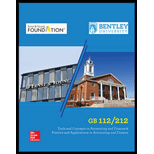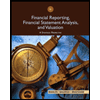
GB 112/212 MANAGERIAL ACC. W/ACCESS >C<
17th Edition
ISBN: 9781260218831
Author: Libby
Publisher: MCG CUSTOM
expand_more
expand_more
format_list_bulleted
Question
Chapter 3, Problem 3.8E
1.
To determine
Prepare the
2.
To determine
Prepare the T-account to calculate the ending
Expert Solution & Answer
Want to see the full answer?
Check out a sample textbook solution
Students have asked these similar questions
Brun Company produces its product through two processing departments: Mixing and Baking. Information for the Mixing department
follows.
Direct Materials
Conversion
Unit
Percent Complete Percent Complete
Beginning work in process inventory
7.500
Units started this period
104,500
Units completed and transferred out 100.000
Ending work in process inventory
12.000
100%
25%
Beginning work in process inventory
Direct materials
Conversion
$6.800
14.500 $21.300
Costs added this period
Drect materials
116,400
Conversion
Total costs to account for
1.067,000 1.183.400
$1.204.700
Required
1. Prepare the Mixing department's production cost report for November using the weighted average method
Check (1) C$1.000
2. Prepare the November 30 journal entry to transfer the cost of completed units from Mixing to Baking
None
Not need ai solution please solve this general accounting question
Chapter 3 Solutions
GB 112/212 MANAGERIAL ACC. W/ACCESS >C<
Ch. 3 - Prob. 1QCh. 3 - Prob. 2QCh. 3 - Write the income statement equation and define...Ch. 3 - Explain the difference between a. Revenues and...Ch. 3 - Define accrual accounting and contrast it with...Ch. 3 - Prob. 6QCh. 3 - Explain the expense recognition principle.Ch. 3 - Explain why stockholders equity is increased by...Ch. 3 - Explain why revenues are recorded as credits and...Ch. 3 - Complete the following matrix by entering either...
Ch. 3 - Complete the following matrix by entering either...Ch. 3 - Prob. 12QCh. 3 - State the equation for the net profit margin ratio...Ch. 3 - Which of the following is not a specific account...Ch. 3 - Which of the following is not one of the criteria...Ch. 3 - The expense recognition principle controls a....Ch. 3 - Prob. 4MCQCh. 3 - Prob. 5MCQCh. 3 - Prob. 6MCQCh. 3 - Prob. 7MCQCh. 3 - Prob. 8MCQCh. 3 - Prob. 9MCQCh. 3 - Prob. 10MCQCh. 3 - Prob. 3.1MECh. 3 - Reporting Cash Basis versus Accrual Basis Income...Ch. 3 - Identifying Revenues The following transactions...Ch. 3 - Identifying Expenses The following transactions...Ch. 3 - Prob. 3.5MECh. 3 - Prob. 3.6MECh. 3 - Determining the Financial Statement Effects of...Ch. 3 - Prob. 3.8MECh. 3 - Prob. 3.9MECh. 3 - Identifying the Operating Activities in a...Ch. 3 - Prob. 3.11MECh. 3 - Prob. 3.1ECh. 3 - Reporting Cash Basis versus Accrual Basis Income...Ch. 3 - Identifying Revenues Revenues are normally...Ch. 3 - Identifying Expenses Revenues are normally...Ch. 3 - Prob. 3.5ECh. 3 - Determining Financial Statement Effects of Various...Ch. 3 - Recording Journal Entries Sysco, formed in 1969,...Ch. 3 - Prob. 3.8ECh. 3 - Prob. 3.9ECh. 3 - Analyzing the Effects of Transactions in...Ch. 3 - Preparing an Income Statement Refer to E3-10....Ch. 3 - Prob. 3.12ECh. 3 - Analyzing the Effects of Transactions in...Ch. 3 - Prob. 3.14ECh. 3 - Prob. 3.15ECh. 3 - Prob. 3.16ECh. 3 - Prob. 3.17ECh. 3 - Prob. 3.18ECh. 3 - Prob. 3.19ECh. 3 - Prob. 3.20ECh. 3 - Prob. 3.1PCh. 3 - Recording Journal Entries (AP3-2) Ryan Terlecki...Ch. 3 - Prob. 3.3PCh. 3 - Prob. 3.4PCh. 3 - Prob. 3.5PCh. 3 - Prob. 3.6PCh. 3 - Prob. 3.7PCh. 3 - Recording Nonquantitative Journal Entries (P3-1)...Ch. 3 - Prob. 3.2APCh. 3 - Prob. 3.3APCh. 3 - Prob. 3.4APCh. 3 - Prob. 3.5APCh. 3 - Prob. 3.6APCh. 3 - Accounting for Operating Activities in a New...Ch. 3 - Finding Financial Information Refer to the...Ch. 3 - Finding Financial Information Refer to the...Ch. 3 - Comparing Companies within an Industry Refer to...Ch. 3 - Analyzing a Company over Time Refer to the annual...Ch. 3 - Prob. 3.6CPCh. 3 - Evaluating an Ethical Dilemma Mike Lynch is the...
Knowledge Booster
Similar questions
- What is the amount of current liabilities the firm has?arrow_forwardNeed answer of this question with financial accountingarrow_forwardThompson Aggrotech has a return on equity of 14.85 percent, a debt-equity ratio of 0.65, and a total asset turnover of 1.1. What is the return on assets?arrow_forward
arrow_back_ios
SEE MORE QUESTIONS
arrow_forward_ios
Recommended textbooks for you
- Business Its Legal Ethical & Global EnvironmentAccountingISBN:9781305224414Author:JENNINGSPublisher:Cengage
 Financial Reporting, Financial Statement Analysis...FinanceISBN:9781285190907Author:James M. Wahlen, Stephen P. Baginski, Mark BradshawPublisher:Cengage Learning
Financial Reporting, Financial Statement Analysis...FinanceISBN:9781285190907Author:James M. Wahlen, Stephen P. Baginski, Mark BradshawPublisher:Cengage Learning Intermediate Accounting: Reporting And AnalysisAccountingISBN:9781337788281Author:James M. Wahlen, Jefferson P. Jones, Donald PagachPublisher:Cengage Learning
Intermediate Accounting: Reporting And AnalysisAccountingISBN:9781337788281Author:James M. Wahlen, Jefferson P. Jones, Donald PagachPublisher:Cengage Learning  Financial And Managerial AccountingAccountingISBN:9781337902663Author:WARREN, Carl S.Publisher:Cengage Learning,
Financial And Managerial AccountingAccountingISBN:9781337902663Author:WARREN, Carl S.Publisher:Cengage Learning, Cornerstones of Cost Management (Cornerstones Ser...AccountingISBN:9781305970663Author:Don R. Hansen, Maryanne M. MowenPublisher:Cengage Learning
Cornerstones of Cost Management (Cornerstones Ser...AccountingISBN:9781305970663Author:Don R. Hansen, Maryanne M. MowenPublisher:Cengage Learning

Business Its Legal Ethical & Global Environment
Accounting
ISBN:9781305224414
Author:JENNINGS
Publisher:Cengage

Financial Reporting, Financial Statement Analysis...
Finance
ISBN:9781285190907
Author:James M. Wahlen, Stephen P. Baginski, Mark Bradshaw
Publisher:Cengage Learning

Intermediate Accounting: Reporting And Analysis
Accounting
ISBN:9781337788281
Author:James M. Wahlen, Jefferson P. Jones, Donald Pagach
Publisher:Cengage Learning

Financial And Managerial Accounting
Accounting
ISBN:9781337902663
Author:WARREN, Carl S.
Publisher:Cengage Learning,

Cornerstones of Cost Management (Cornerstones Ser...
Accounting
ISBN:9781305970663
Author:Don R. Hansen, Maryanne M. Mowen
Publisher:Cengage Learning